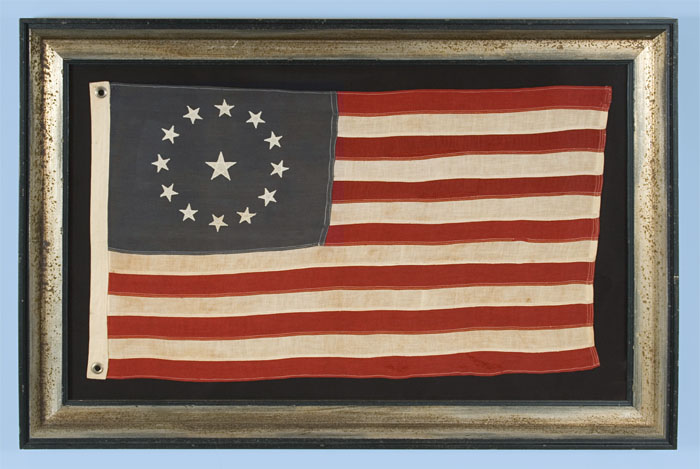
| |
13 STARS IN THE 3RD MARYLAND PATTERN, 1926 SESQUICENTENNIAL - WWII ERA |
|
| Available: |
Sold |
| Frame Size (H x L): |
30" x 45" |
| Flag Size (H x L): |
21" x 35.5" |
|
| Description....: |
|
13 STARS IN THE 3RD MARYLAND PATTERN,
1926 SESQUICENTENNIAL - WWII ERA:
13 star American national flag made in the period between the 1926 sesquicentennial (150-year anniversary) of our nation's independence and WWII (1941-45). There is an oval wreath of twelve stars, surrounding a much larger center star. This configuration is commonly referred to as the 3rd Maryland pattern and is very desirable due to both its attractiveness and the scarcity of its use. The name comes from a flag that was thought to have been present with General Daniel Morgan and the Maryland Light at the battle of Cowpens in 1781, carried by Color Sergeant William Batchelor. But the Cowpens flag, which now resides at the state capital in Annapolis, was later discovered to be of Mexican War origin (1846-48) at the earliest. A similar flag, in the collection of the Smithsonian's National Museum of History & Technology, was also carried during the Mexican War, belonging to the Maryland and District of Columbia Battalion of Volunteers.
This small sized flag of the type generally used on private boats during the last decade of the 19th century and the 1st quarter of the 20th century, but the 3rd MD star configuration is seldom seen on private yachting ensigns. In addition, nautical flags were generally made of wool, which sheds water and was an excellent fabric for outdoor use during inclement weather. The fact that this flag is made of cotton and that its stars appear in this pattern suggests that it may have more likely been made for general patriotic use on land.
Note how the proportions of this flag are slightly elongated. With the exception of flags made for the Executive Branch of the Federal Government, there are no laws concerning the proportions of the American flag. In other words, the proportions of a Stars & Stripes made for any other use are up to the discretion of the flag-maker or the party who orders the flags to be made. Also note the dusty blue coloration of the canton, which was caused by the fading of a fugitive dye. Flags with this color that have survived to the present day have an interesting appearance that many collectors find attractive.
13 star flags have been used throughout our Nation's history for a variety of purposes. In addition to their use at the Sesquicentennial and on private yachts, the U.S. Navy used the 13 star count on small boats through most or all of the 19th century, particularly the second half. The Navy's use of the 13 star flag ended in 1916 following an executive order of President Wilson. 13 star flags were displayed during Lafayette's final visit to the U.S. in 1824-25, carried by soldiers during the both the Mexican and Civil Wars (1846-48 and 1861-65, respectively), and flown during the celebration of the Nation's centennial of independence in 1876. They also saw use on other patriotic occasions.
Construction: The flag is made entirely of cotton and sewn by machine. The canton, stripes, and sleeve are sewn with a lineal stitch, while the stars were sewn with a zigzag stitch. There are two metal grommets for hoisting.
Mounting: The flag has been hand-stitched to 100% silk organza on every seam for support. The flag was then hand-sewn to a 100% cotton background, black in color. The black fabric was washed to remove excess dye. An acid-free, dye-setting agent was added to the wash o further set the dye and the fabric was heat-treated for the same purpose. The mount is backed with archival material and placed in a black painted, hand-gilded and distressed Italian molding. Spacers keep the textile away from the glass, which is u.v. protective. |
|
|
|
| Collector Level: |
Beginners and Holiday Gift Giving |
|
| Flag Type: |
|
|
| Star Count: |
13 |
|
| Earliest Date of Origin: |
1926 |
|
| Latest Date of Origin: |
1945 |
|
| State/Affiliation: |
13 Original Colonies |
|
| War Association: |
|
|
| Price: |
Sold |
|
| |
Views: 3893 |
|
|
|

